Lead Affects Vitamin D Metabolism in Rats
Abstract
:1. Introduction
2. Materials and Methods
2.1. Pb Exposure Protocol
2.2. Collection of Blood and Tissue Samples
2.3. Pb Analysis
2.4. Vitamin D Metabolites Analysis
2.5. Western Blotting
2.6. Immunohistochemistry
2.7. Statistical Analysis
3. Results
3.1. Effect of Pb Exposure on Serum Vitamin D Metabolites
3.2. Effects of Pb Exposure on 1-α-Hydroxylase Expression and Distribution in Cerebrum and Kidney
3.3. Effects of Pb Exposure on 25-Hydroxylase Expression in Liver
3.4. Effects of Pb Exposure on VDR Expression in Cerebrum
4. Discussion
4.1. Model Appropriateness and Pb Exposure Protocol
4.2. Effects of Pb on Serum VD Metabolism
4.3. Effects of Pb on VDR
4.4. Study Limitations
5. Conclusions
Acknowledgments
Author Contributions
Conflicts of Interest
Abbreviations
| Pb | lead |
| VDD | vitamin D deficiency |
| 25(OH)D | 25-Hydroxyvitamin D |
| 1,25(OH)2D | 1, 25-Dihydroxyvitamin D |
| VDR | Vitamin D receptor |
| CYP27A1 | 25-Hydroxylase |
| CYP27B1 | 1α-Hydroxylase |
| PTH | Parathyroid hormone |
| PND | Postnatal day |
| BPbL | Blood lead level |
| LC-MS/MS | Liquid chromatography-tandem mass spectrometry |
| ICP-OES | Inductively coupled plasma-optical emission spectrometer |
References
- DeLuca, H. Overview of general physiologic features and functions of vitamin D. Am. J. Clin. Nutr. 2004, 80, 1689S–1696S. [Google Scholar] [CrossRef] [PubMed]
- DeLuca, G.; Kimball, S.; Kolasinski, J.; Ramagopalan, S.; Ebers, G. Review: The role of vitamin D in nervous system health and disease. Neuropathol. Appl. Neurobiol. 2013, 39, 458–484. [Google Scholar] [CrossRef] [PubMed]
- Eyles, D.; Burne, T.; McGrath, J. Vitamin D, effects on brain development, adult brain function and the links between low levels of vitamin D and neuropsychiatric disease. Front. Neuroendocrinol. 2013, 34, 47–64. [Google Scholar] [CrossRef] [PubMed]
- Eyles, D.; Smith, S.; Kinobe, R.; Hewison, M.; McGrath, J. Distribution of the Vitamin D receptor and 1α-hydroxylase in human brain. J. Chem. Neuroanat. 2005, 29, 21–30. [Google Scholar] [CrossRef] [PubMed]
- Buell, J.; Scott, T.; Dawson-Hughes, B.; Dallal, G.; Rosenberg, I.; Folstein, M.; Tucker, K. Vitamin D is associated with cognitive function in elders receiving home health services. J. Gerontol. A Biol. Sci. Med. Sci. 2009, 64, 888–895. [Google Scholar] [CrossRef] [PubMed]
- Lidsky, T.; Schneider, J. Lead neurotoxicity in children: Basic mechanisms and clinical correlates. Brain 2003, 126, 5–19. [Google Scholar] [CrossRef] [PubMed]
- Liu, K.; Hao, J.; Zeng, Y.; Dai, F.; Gu, P. Neurotoxicity and biomarkers of lead exposure: A review. Chin. Med. Sci. J. 2013, 28, 178–188. [Google Scholar] [CrossRef]
- Mason, L.; Harp, J.; Han, D. Pb Neurotoxicity: Neuropsychological Effects of Lead Toxicity. BioMed Res. Int. 2014, 2014, 1–8. [Google Scholar] [CrossRef] [PubMed]
- Centers for Disease Control and Prevention. Lead. Workplace Safety & Health Topics. CDC. 2013. Available online: http://www.cdc.gov/niosh/topics/lead/ (accessed on 15 March 2017).
- Kim, H.; Jang, T.; Chae, H.; Choi, W.; Ha, M.; Ye, B.; Kim, B.; Jeon, M.; Kim, S.; Hong, Y. Evaluation and management of lead exposure. AOEM 2015, 27, 1–9. [Google Scholar] [CrossRef] [PubMed]
- Mithal, A.; Wahl, D.; Bonjour, J.; Burckhardt, P.; Dawson-Hughes, B.; Eisman, J.; El-Hajj Fuleihan, G.; Josse, R.G.; Lips, P.; Morales-Torres, J.; et al. Global vitamin D status and determinants of hypovitaminosis D. Osteoporos. Int. 2009, 20, 1807–1820. [Google Scholar] [CrossRef] [PubMed]
- Van Schoor, N.; Lips, P. Worldwide vitamin D status. Best Pract. Res. Clin. Endocrinol. Metab. 2011, 25, 671–680. [Google Scholar] [CrossRef] [PubMed]
- Rahman, A.; Al-Rashidi, H.; Khan, A. Association of Maternal Blood Lead Level during Pregnancy with Child Blood Lead Level and Pregnancy Outcome in Kuwait. Ecol. Food Nutr. 2012, 51, 40–57. [Google Scholar] [CrossRef] [PubMed]
- Hilger, J.; Friedel, A.; Herr, R.; Rausch, T.; Roos, F.; Wahl, D.; Pierroz, D.; Weber, P.; Hoffmann, K. A systematic review of vitamin D status in populations worldwide. Br. J. Nutr. 2013, 111, 23–45. [Google Scholar] [CrossRef] [PubMed]
- Palacios, C.; Gonzalez, L. Is vitamin D deficiency a major global public health problem? J. Steroid Biochem. Mol. Biol. 2014, 144, 138–145. [Google Scholar] [CrossRef] [PubMed]
- Centers for Disease Control and Prevention. Lead (Pb) Toxicity: What Are the U.S. Standards for Lead Levels? 2016. Available online: https://www.atsdr.cdc.gov/csem/csem.asp?csem=34&po=8 (accessed on 15 March 2017).
- Tarragó, O.; Demers, R.; Becker, C.; Borak, J.; Cannella, J.; Goldstein, B.; Hall, A.; Jackson, R.; Rodnick, J.; Wheater, R.; et al. Lead Toxicity: Case Studies in Environmental Medicine (CSEM), 1st ed.; Agency for Toxic Substances and Disease Registry (ATSDR): Atlanta, GA, USA, 2012. [Google Scholar]
- Budtz-Jørgensen, E.; Bellinger, D.; Lanphear, B.; Grandjean, P. An international pooled analysis for obtaining a benchmark dose for environmental lead exposure in children. Risk Anal. 2012, 33, 450–461. [Google Scholar] [CrossRef] [PubMed]
- Nicholson, J.; Cleeton, M. Validation and Assessment of Pediatric Lead Screener Questions for Primary Prevention of Lead Exposure. Clin. Pediatr. 2016, 55, 129–136. [Google Scholar] [CrossRef] [PubMed]
- Dongre, N.; Suryakar, A.; Patil, A.; Hundekari, I.; Devarnavadagi, B. Biochemical effects of lead exposure on battery manufacture workers with reference to blood pressure, calcium metabolism and bone mineral density. Indian J. Clin. Biochem. 2012, 28, 65–70. [Google Scholar] [CrossRef] [PubMed]
- Mazumdar, I.; Goswami, K.; Ali, M. Status of serum calcium, vitamin D and parathyroid hormone and hematological indices among lead exposed jewelry workers in Dhaka, Bangladesh. Indian J. Clin. Biochem. 2016, 32, 110–116. [Google Scholar] [CrossRef] [PubMed]
- Sorrell, M.; Rosen, J.; Roginsky, M. Interactions of lead, calcium, vitamin D and nutrition in lead-burdened children. Arch. Environ. Health 1977, 32, 160–164. [Google Scholar] [CrossRef] [PubMed]
- Rosen, J.F.; Chesney, R.W.; Hamstra, A.; DeLuca, H.F.; Mahaffey, K.R. Reduction in 1,25-dihydroxyvitamin D in children with increased lead absorption. N. Engl. J. Med. 1980, 302, 1128–1131. [Google Scholar] [CrossRef] [PubMed]
- Mahaffey, K.; Rosen, J.; Chesney, R.; Peeler, J.; Smith, C.; DeLuca, H. Association between age, blood lead concentration and serum 1,25-dihydroxycholecalciferol levels in children1–3. Am. J. Clin. Nutr. 1982, 35, 1327–1331. [Google Scholar] [CrossRef] [PubMed]
- Chang, L.; Liu, X.; Shi, H.; Dai, W.; Wang, H.; Jiang, Y. Association of 25-hydroxyvitamin D with Hb and lead in children: A Chinese population-based study. Public Health Nutr. 2013, 17, 827–832. [Google Scholar] [CrossRef] [PubMed]
- Smith, H.; DeLuca, C.; Tanaka, Y.; Mahaffey, K. Effect of lead ingestion on functions of vitamin D and its metabolites. J. Nutr. 1981, 111, 1321–1329. [Google Scholar] [CrossRef] [PubMed]
- Schwalfenberg, G.; Genuis, S. Vitamin D, essential minerals and toxic elements: Exploring interactions between nutrients and toxicants in clinical medicine. Sci. World J. 2015, 2015, 1–8. [Google Scholar] [CrossRef] [PubMed]
- Fowler, B. Measuring Lead Exposure in Infants, Children and Other Sensitive Populations, 1st ed.; National Academy Press: Washington, DC, USA, 1993; p. 356. [Google Scholar]
- Patrick, L. Lead Toxicity, a Review of the Literature. Part I: Exposure, Evaluation and Treatment. Altern. Med. Rev. 2006, 11, 1–22. [Google Scholar]
- Monir, A.; Gundberg, C.; Yagerman, S.; van der Meulen, M.; Budell, W.; Boskey, A.; Dowd, T. The effect of lead on bone mineral properties from female adult C57/BL6 mice. Bone 2010, 47, 888–894. [Google Scholar] [CrossRef] [PubMed]
- Anticona, C.; Sebastian, M. Anemia and malnutrition in indigenous children and adolescents of the Peruvian Amazon in a context of lead exposure: A cross-sectional study. Glob. Health Action 2014, 7, 1–8. [Google Scholar] [CrossRef] [PubMed]
- Al-Harbi, A.N.; Khan, K.M.; Rahman, A. Developmental Vitamin D Deficiency Affects Spatial Learning in Wistar Rats. J. Nutr. 2017, 147, 1–11. [Google Scholar] [CrossRef] [PubMed]
- Deveci, E. Ultrastructural effects of lead acetate on brain of rats. Toxicol. Ind. Health 2006, 22, 419–422. [Google Scholar] [CrossRef] [PubMed]
- Rahman, A.; Khan, K.; Al-Khaledi, G.; Khan, I.; Al-Shemary, T. Over activation of hippocampal serine/threonine protein phosphatases PP1 and PP2A is involved in lead-induced deficits in learning and memory in young rats. Neurotoxicology 2012, 33, 370–383. [Google Scholar] [CrossRef] [PubMed]
- Basha, C.; Reddy, R. Long-term changes in brain cholinergic system and behavior in rats following gestational exposure to lead: Protective effect of calcium supplement. Interdiscip. Toxicol. 2015, 8, 158–168. [Google Scholar] [CrossRef] [PubMed]
- Nehru, B.; Kaushal, S. Alterations in the hepatic enzymes following experimental lead poisoning. Biol. Trace Elem. Res. 1993, 38, 27–34. [Google Scholar] [CrossRef] [PubMed]
- Mujaibel, L.; Kilarkaje, N. Mitogen-activated protein kinase signaling and its association with oxidative stress and apoptosis in lead-exposed hepatocytes. Environ. Toxicol. 2013, 30, 513–529. [Google Scholar] [CrossRef] [PubMed]
- Haouas, Z.; Sallem, A.; Zidi, I.; Hichri, H.; Mzali, I.; Mehdi, M. Hepatotoxic Effects of Lead Acetate in Rats: Histopathological and Cytotoxic Studies. J. Cytol. Histol. 2014, 5, 256–261. [Google Scholar]
- Nolan, C.; Shaikh, Z. Lead nephrotoxicity and associated disorders: Biochemical mechanisms. Toxicology 1992, 73, 127–146. [Google Scholar] [CrossRef]
- Ghorbe, F.; Boujelbene, M.; Makni-Ayadi, F.; Guermazi, F.; Kammoun, A.; Murat, J.; Croute, F.; Soleilhavoup, J.; El-Feki, A. Effect of Chronic Lead Exposure on Kidney Function in Male and Female Rats: Determination of a Lead Exposure Biomarker. Arch. Physiol. Biochem. 2001, 109, 457–463. [Google Scholar] [CrossRef] [PubMed]
- Odigie, I.P.; Ladipo, C.O.; Ettarh, R.R.; Izegbu, M.C. Effect of chronic exposure to low levels of lead on renal function and renal ultrastructure in SD rats. Niger. J. Physiol. Sci. 2004, 19, 27–32. [Google Scholar] [CrossRef]
- Zhu, Z.; Yang, R.; Dong, G.; Zhao, Z. Study on the neurotoxic effects of low-level lead exposure in rats. J. Zhejiang Univ. Sci. B 2005, 6, 686–692. [Google Scholar] [CrossRef] [PubMed]
- Feng, C.; Gu, J.; Zhou, F.; Li, J.; Zhu, G.; Guan, L.; Liu, H.; Du, G.; Feng, J.; Liu, D.; et al. The effect of lead exposure on expression of SIRT1 in the rat hippocampus. Environ. Toxicol. Pharmacol. 2016, 44, 84–92. [Google Scholar] [CrossRef] [PubMed]
- Guariglia, S.; Stansfield, K.; McGlothan, J.; Guilarte, T. Chronic early life lead (Pb2+) exposure alters presynaptic vesicle pools in hippocampal synapses. BMC Pharmacol. Toxicol. 2016, 17, 56–63. [Google Scholar] [CrossRef] [PubMed]
- Keeney, J.; Förster, S.; Sultana, R.; Brewer, L.; Latimer, C.; Cai, J.; Klein, J.; Porter, N.; Butterfield, D. Dietary vitamin D deficiency in rats from middle to old age leads to elevated tyrosine nitration and proteomics changes in levels of key proteins in brain: Implications for low vitamin D-dependent age-related cognitive decline. Free Radic. Biol. Med. 2013, 65, 324–334. [Google Scholar] [CrossRef] [PubMed]
- Trechsel, U.; Taylor, C.; Eisman, J.; Bonjour, J.; Fleisch, H. Plasma Levels of Vitamin D Metabolites in Diphosphonate Treated Rats. Clin. Sci. 1981, 61, 471–476. [Google Scholar] [CrossRef] [PubMed]
- Stavenuiter, A.; Arcidiacono, M.; Ferrantelli, E.; Keuning, E.; Vila Cuenca, M.; ter Wee, P.; Beelen, R.; Vervloet, M.; Dusso, A. A Novel Rat Model of Vitamin D Deficiency: Safe and Rapid Induction of Vitamin D and Calcitriol Deficiency without Hyperparathyroidism. BioMed Res. Int. 2015, 2015, 1–5. [Google Scholar] [CrossRef] [PubMed]
- Sonneveld, R.; Hoenderop, J.; Stavenuiter, A.; Ferrantelli, E.; Baltissen, M.; Dijkman, H.; Florquin, S.; Rops, A.; Wetzels, J.; Berden, J.; et al. 1,25-Vitamin D3 Deficiency Induces Albuminuria. Am. J. Pathol. 2016, 186, 794–804. [Google Scholar] [CrossRef] [PubMed]
- Jackson, L.; Cromer, B.; Panneerselvamm, A. Association between bone turnover, micronutrient intake and blood lead levels in pre- and postmenopausal women, NHANES 1999–2002. Environ. Health Perspect. 2010, 118, 1590–1596. [Google Scholar] [CrossRef] [PubMed]
- Kersey, M.; Chi, M.; B Cutts, D. Anaemia, lead poisoning and vitamin D deficiency in low-income children: Do current screening recommendations match the burden of illness? Public Health Nutr. 2011, 14, 1424–1428. [Google Scholar] [CrossRef] [PubMed]
- Murray, R.; Granner, D.; Mayes, P.; Rodwell, V. Harper’s Illustrated Biochemistry, 26th ed.; McGraw-Hill: New York, NY, USA, 2003; p. 693. [Google Scholar]
- Omdahl, J.; Morris, H.; May, B. Hydroxylase enzymes of the vitamin D pathway: Expression, Function and Regulation. Annu. Rev. Nutr. 2002, 22, 139–166. [Google Scholar] [CrossRef] [PubMed]
- Bikle, D. Vitamin D metabolism, mechanism of action and clinical applications. Chem. Biol. 2014, 21, 319–329. [Google Scholar] [CrossRef] [PubMed]
- Potula, V.; Henderson, A.; Kaye, W. Calcitropic Hormones, Bone Turnover and Lead Exposure among Female Smelter Workers. Arch. Environ. Occup. Health 2005, 60, 195–204. [Google Scholar] [CrossRef] [PubMed]
- Kristal-Boneh, E.; Froom, P.; Yerushalmi, N.; Harari, G.; Ribak, J. Calcitropic hormones and occupational lead exposure. Am. J. Epidemiol. 1998, 147, 458–463. [Google Scholar] [CrossRef] [PubMed]
- Fullmer, C. Lead–Calcium Interactions: Involvement of 1,25-Dihydroxyvitamin D. Environ. Res. 1997, 72, 45–55. [Google Scholar] [CrossRef] [PubMed]
- Harms, L.; Burne, T.; Eyles, D.; McGrath, J. Vitamin D and the brain. Best Pract. Res. Clin. Endocrinol. Metab. 2011, 25, 657–669. [Google Scholar] [CrossRef] [PubMed]
- Annweilera, C.; Montero-Odassob, M.; Llewellynd, D.; Richard-Devantoye, S.; Duquef, G.; Beaucheta, O. Meta-analysis of memory and executive dysfunctions in relation to vitamin D. J. Alzheimers Dis. 2013, 37, 147–171. [Google Scholar]
- Latimer, C.; Brewer, L.; Searcy, J.; Chen, K.; Popovic, J.; Kraner, S.; Thibault, O.; Blalock, E.; Landfield, P.; Porter, N. Vitamin D prevents cognitive decline and enhances hippocampal synaptic function in aging rats. Proc. Natl. Acad. Sci. USA 2014, 111, E4359–E4366. [Google Scholar] [CrossRef] [PubMed]
- Kuźma, E.; Soni, M.; Littlejohns, T.; Ranson, J.; Van Schoor, N.; Deeg, D.; Comijs, H.; Chaves, P.; Kestenbaum, B.; Kuller, L.; et al. Vitamin D and memory decline: Two population-based prospective studies. J. Alzheimers Dis. 2016, 50, 1099–1108. [Google Scholar] [CrossRef] [PubMed]
- Slvsten, H.; Svendsen, M.; Fogh, K.; Kragballe, K. Upregulation of vitamin D receptor levels by 1,25(OH)2 vitamin D3 in cultured human keratinocytes. Arch. Dermatol. Res. 1997, 289, 367–372. [Google Scholar]
- Onalaja, A.; Claudio, L. Genetic susceptibility to lead poisoning. Environ. Health Perspect. 2000, 108, 23–28. [Google Scholar] [CrossRef] [PubMed]
- Pawlas, N.; Broberg, K.; Olewińska, E.; Prokopowicz, A.; Skerfving, S.; Pawlas, K. Modification by the genes ALAD and VDR of lead-induced cognitive effects in children. Neurotoxicology 2012, 33, 37–43. [Google Scholar] [CrossRef] [PubMed]
- Pawlas, N.; Broberg, K.; Olewińska, E.; Kozłowska, A.; Skerfving, S.; Pawlas, K. Genetic modification of ALAD and VDR on lead-induced impairment of hearing in children. Environ. Toxicol. Pharmacol. 2015, 39, 1091–1098. [Google Scholar] [CrossRef] [PubMed]
- Kaya-Akyüzlü, D.; Kayaalti, Z.; Söylemez, E.; Koca, D.; Söylemezoğlu, T. Does maternal VDR FokI single nucleotide polymorphism have an effect on lead levels of placenta, maternal and cord bloods? Placenta 2015, 36, 870–875. [Google Scholar] [CrossRef] [PubMed]
- Jhun, M.; Hu, H.; Schwartz, J.; Weisskopf, M.; Nie, L.; Sparrow, D.; Vokonas, P.; Park, S. Effect modification by vitamin D receptor genetic polymorphisms in the association between cumulative lead exposure and pulse pressure: A longitudinal study. Environ. Health 2015, 14, 5–13. [Google Scholar] [CrossRef] [PubMed]
- Dong, Q.; Zhao, C.; Chen, F.; Ji, H.; Zhang, X.; Hao, H.; Li, Z.; Li, J.; Yuan, J. The relationship of vitamin D receptor gene and blood lead: A meta-analysis. Eur. PMC Plus 2016, 34, 206–209. [Google Scholar]


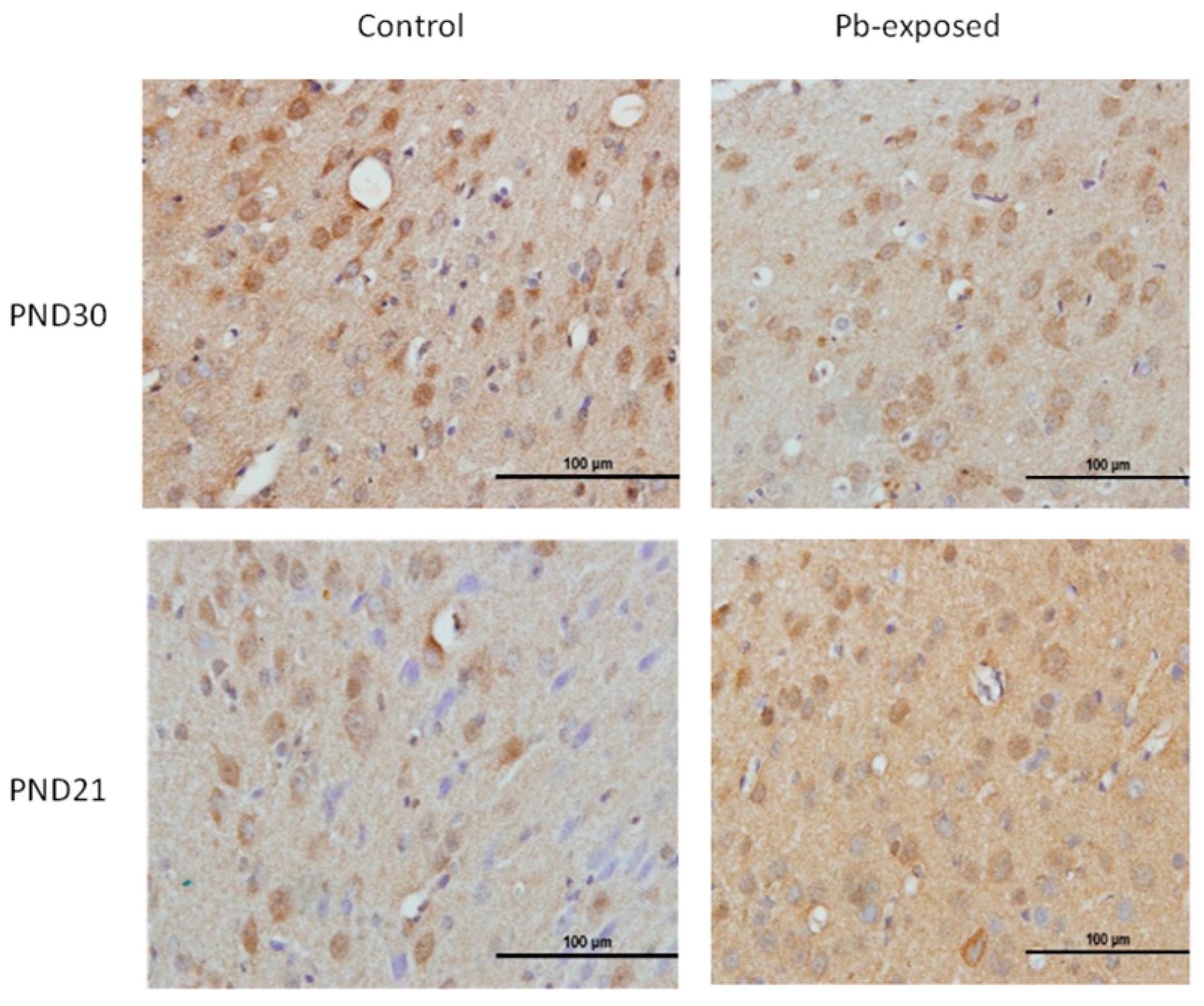

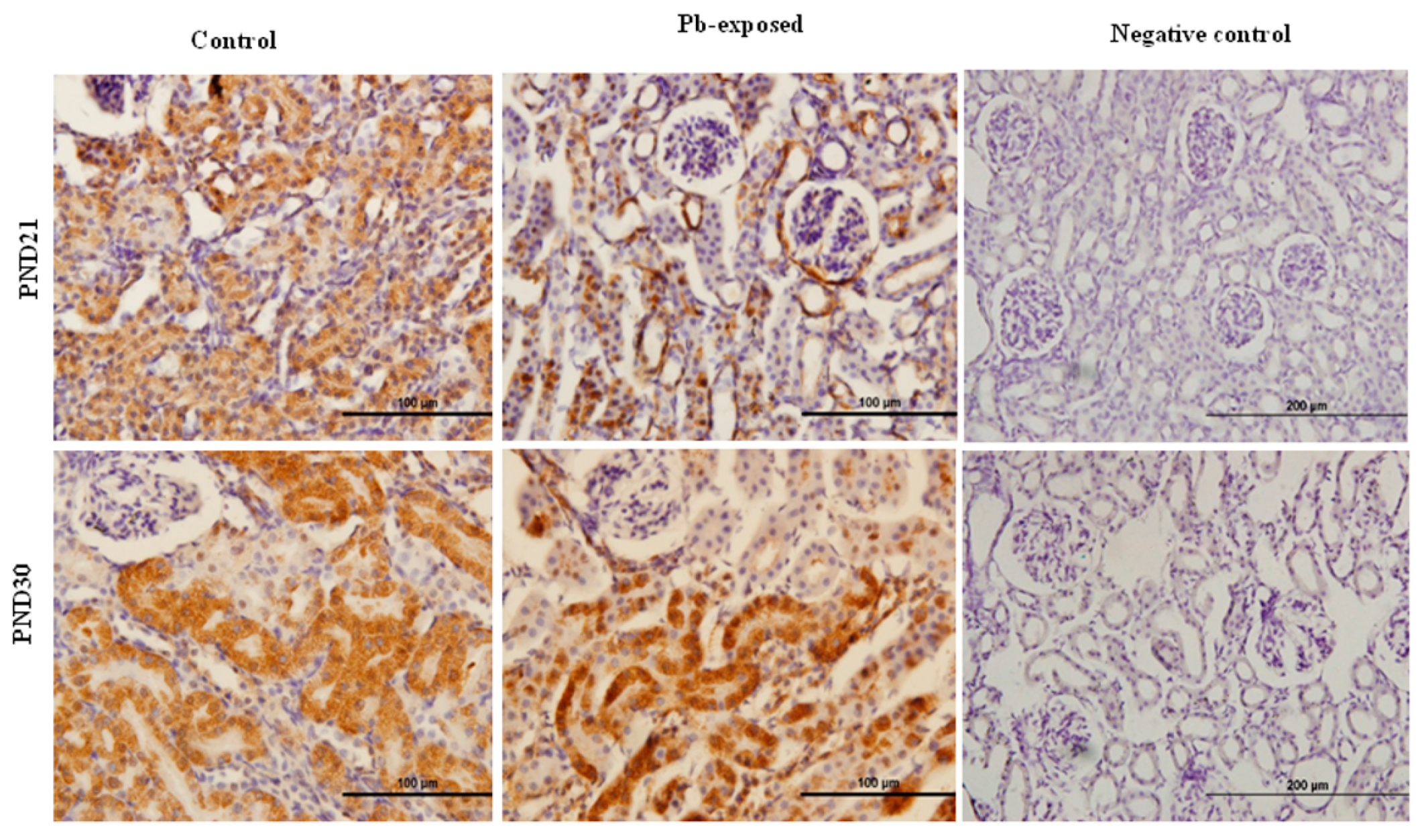
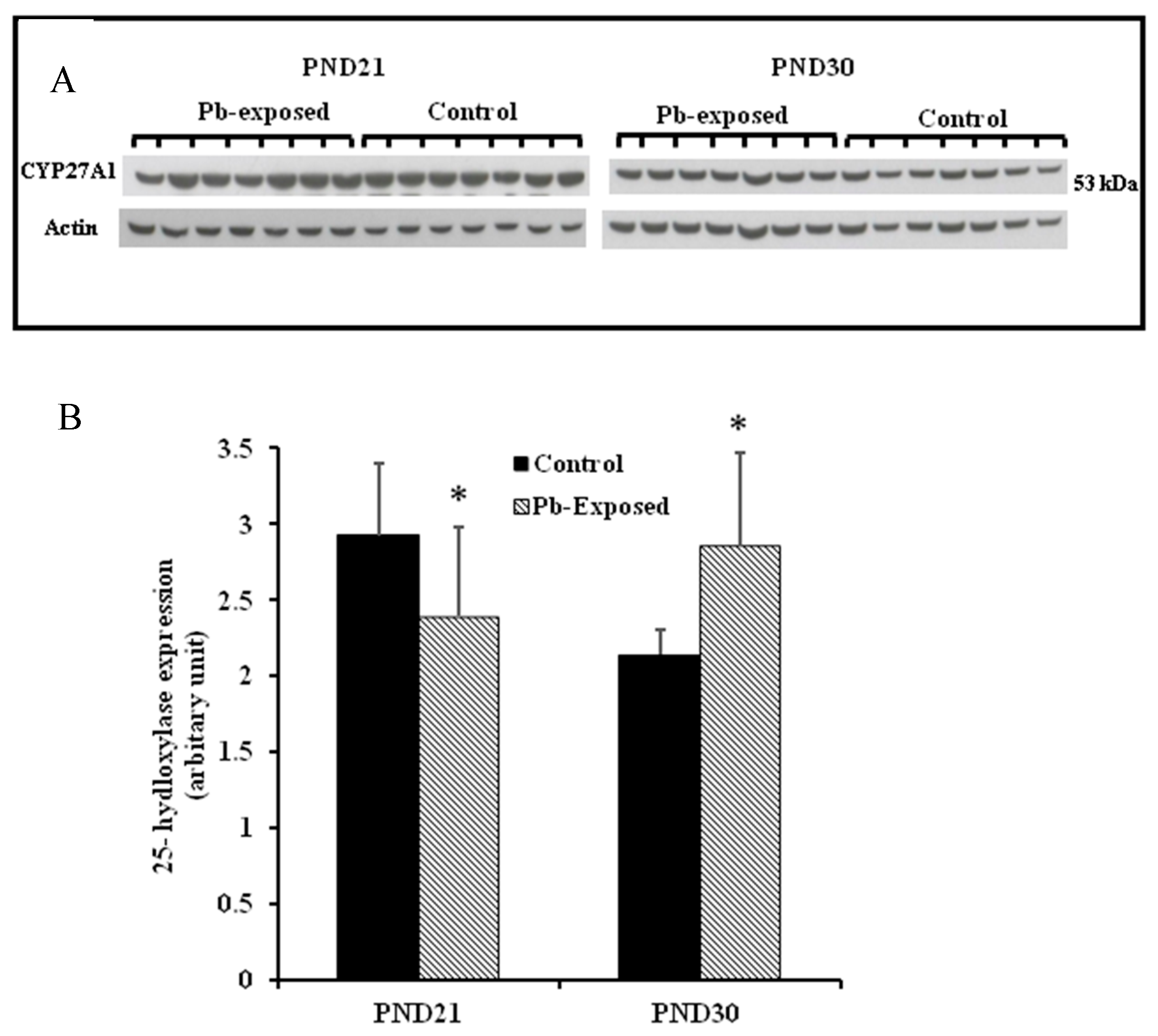

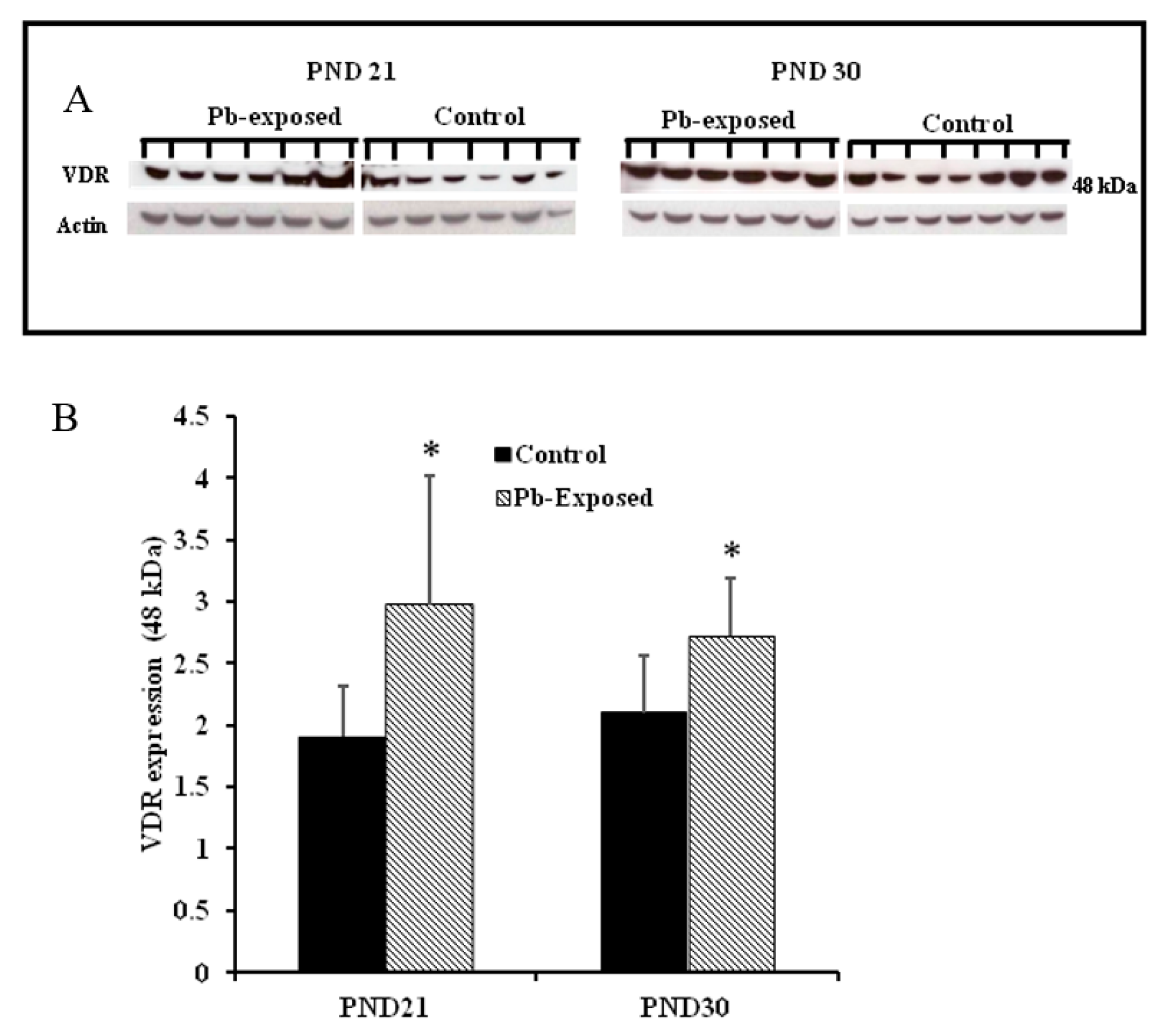
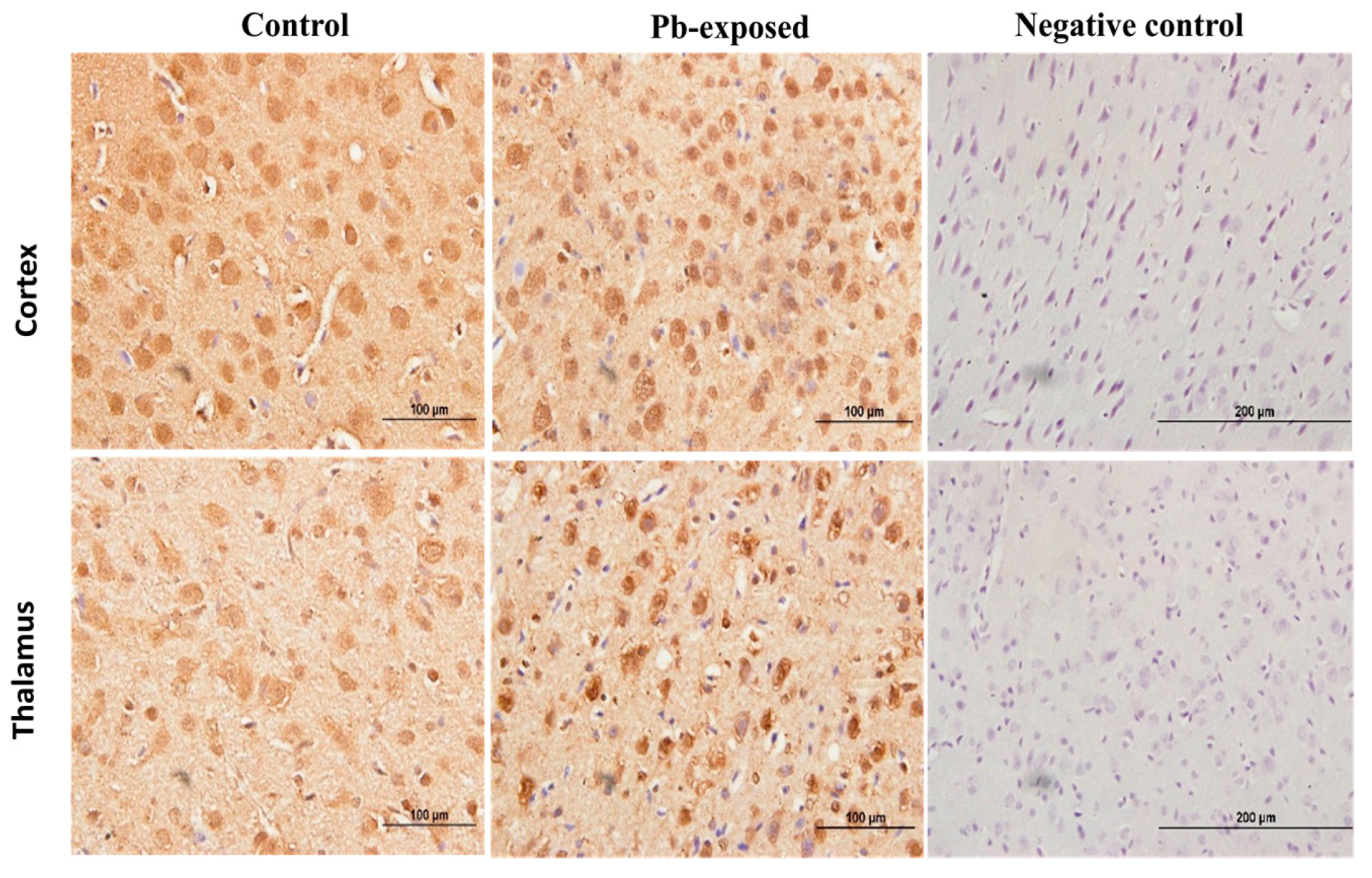

| Primary Antibody | Tissue | Colonality | Dilution | Source |
|---|---|---|---|---|
| Anti-CYP27B1 (1-α-hydroxylase) | Brain, kidney | polyclonal | 1:1000 for WB 1:100 for IHC | USCN Life Sciences Inc., Wuhan, China |
| Anti-CYP27A1 (25-hydroxylase) | Liver | monoclonal | 1:1000 for WB 1:100 for IHC | Abcam, Cambridge, MA, USA |
| VDR antibody | Brain | monoclonal | 1:1000 for WB and IHC | Aviva systems biology, San Diego, CA, USA |
| Anti-β-actin | All the above tissues | monoclonal | 1:2000 | Sigma-Aldrich, St. Louis, MO, USA |
| PND21 | PND30 | |||
|---|---|---|---|---|
| Control | Pb-Exposed | Control | Pb-Exposed | |
| (n = 20) | (n = 20) | (n = 19) | (n = 19) | |
| Body weight | 35.0 ± 3.2 | 33.0 ± 7.8 | 71.1 ± 7.1 | 71.6 ± 13.6 |
| Brain weight | 1.3 ± 0.1 | 1.3 ± 0.1 | 1.4 ± 0.2 | 1.3 ± 0.2 |
| Liver weight | 1.2 ± 0.2 | 1.2 ± 0.3 | 1.9 ± 0.2 | 1.8 ± 0.3 |
| Kidney weight | 0.4 ± 0.1 | 0.4 ± 0.1 | 0.8 ± 0.1 | 0.9 ± 0.2 |
| PND21 | PND30 | |||
|---|---|---|---|---|
| Control (n = 19) | Pb-Exposed (n = 20) | Control (n = 19) | Pb-Exposed (n = 20) | |
| Pb (μg/dL) | 2.2 ± 0.7 | 12.4 ± 3.3 ** | 3.3 ± 1.7 | 22.7 ± 6.0 ** |
| 25(OH)D (nmol/L) | 32.2 ± 7.5 | 23.3 ± 5.7 * | 32.2 ± 6.3 | 27.0 ± 6.4 * |
| 1,25(OH)2D (pmol/L) | 428.8 ± 132.8 | 361.5 ± 83.6 * | 416.9 ± 129.1 | 379.7 ± 108.1 |
© 2018 by the authors. Licensee MDPI, Basel, Switzerland. This article is an open access article distributed under the terms and conditions of the Creative Commons Attribution (CC BY) license (http://creativecommons.org/licenses/by/4.0/).
Share and Cite
Rahman, A.; Al-Awadi, A.A.; Khan, K.M. Lead Affects Vitamin D Metabolism in Rats. Nutrients 2018, 10, 264. https://doi.org/10.3390/nu10030264
Rahman A, Al-Awadi AA, Khan KM. Lead Affects Vitamin D Metabolism in Rats. Nutrients. 2018; 10(3):264. https://doi.org/10.3390/nu10030264
Chicago/Turabian StyleRahman, Abdur, Ameena A. Al-Awadi, and Khalid M. Khan. 2018. "Lead Affects Vitamin D Metabolism in Rats" Nutrients 10, no. 3: 264. https://doi.org/10.3390/nu10030264





